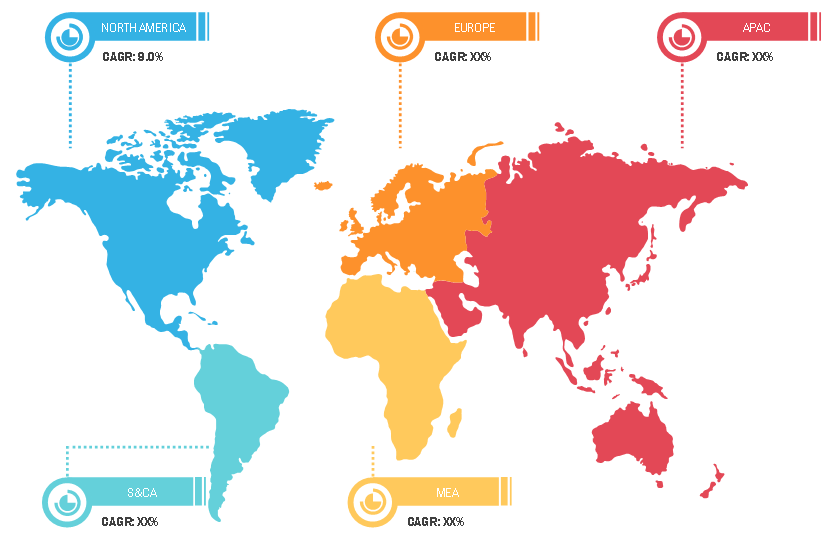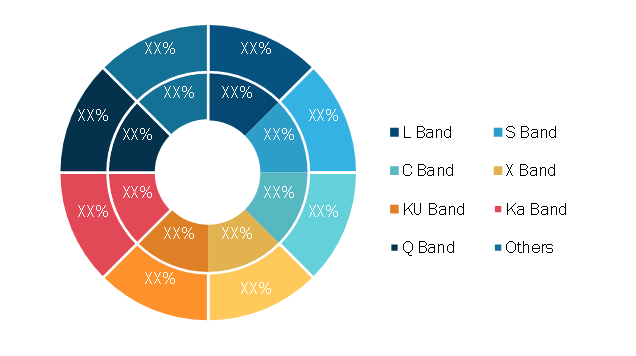The microwave transmission equipment market was valued at US$ 3,135.6 million in 2020 and is projected to reach US$ 5,330.1 million by 2028; it is expected to grow at a CAGR of 7.3% from 2021 to 2028.
The reach of backhaul media varies across different parts of the network geography, which can be attributed to factors such as market maturity in fixed and mobile telecoms and government incentives. Moreover, the overall share of the microwave technology in the overall backhaul Microwave Transmission Equipment market is likely to decline in the coming years; however, the number of macro and small cell base stations would continue to rise, which would boost the total number of microwave-connected base stations. North America is one of the early regions to roll out the LTE. Due to a lack of readily available fiber and failure of existing copper-based infrastructure, the share of microwave technology has increased in backhaul deployments in the last few years. Western Europe is a mature market in fiber deployment, particularly in densely populated areas. However, the transition to fiber in other parts of the world, such as Africa, India, and the Middle East, is likely to take longer because of factors such as rights of way, i.e., the legal right, established by usage or grant, to pass along a specific route through grounds or property belonging to another. Nevertheless, the majority of mobile broadband networks would be deployed using microwave backhaul. Latin America is expected to make a quick switch to fiber on the back of government initiatives and operator investments.
Lucrative Regions for Microwave Transmission Equipment Providers

- Sample PDF showcases the content structure and the nature of the information with qualitative and quantitative analysis.
- Sample PDF showcases the content structure and the nature of the information with qualitative and quantitative analysis.
Microwave Transmission Equipment Market Insights
Advancements in 4G, LTE Advanced, and Other New Connectivity Technology Standards
Mobile coverage and capacity are rapidly evolving with the ongoing expansion and improvements in 3G networks; rollout of new 4G networks; addition of complementary coverage solutions such as pico, Wi-Fi, micro, and indoor solutions; and consolidation of 5G rollout plans. Many mobile network operators (MNOs) have made significant investments in LTE rollouts worldwide, as a part of planned transition from 2G/3G networks to the 4G network. The LTE deployment has been critical in improving the Mobile Broadband (MBB) proposition and improving coverage, as well as offering more competitive data tariffs and affordable high-speed internet devices. According to GSMA statistics, 782 operators had invested in LTE across 200 countries as of July 2017, with up to 601 LTE networks commercially deployed and launched in 192 countries.
The microwave transmission solutions help in meeting virtually every conceivable backhaul requirement, such as with gigabit-per-second capabilities. Microwave transmission solutions provide increased spectrum efficiency, support for efficient IP data transmission, and increasing levels of optimization and automation, which makes them an important part of operators' network evolution to 2020.
Network Technology Based Market Insights
Based on network technology, the microwave transmission equipment market is segmented into packet microwave, hybrid microwave, small-cell backhaul, and time division multiplexing. The packet microwave segment dominated the market in 2020. The penetration of packet technologies in microwave communication systems have changed the functioning of microwave system and complied to specified service-level agreement (SLA) such as performance and availability.
Component Based Market Insights
Based on component, the microwave transmission equipment market is segmented into antennas, RF processing units, indoor units, outdoor units, and cables and connector. The outdoor units segment dominated the market in 2020. ODU is responsible for the frequency conversion and amplification of the signal. For instance, radio tower is an example of ODU includes microwave antenna, power & optic cables, and system station.
Frequency Band Based Market Insights
Based on frequency band, the microwave transmission equipment market is segmented into L Band, S Band, C Band, X Band, Ku Band, Ka Band, Q Band, and others. The C band segment dominated the market in 2020. The C band are majorly chosen over Ku band for satellite as they are less vulnerable to rain fade than Ku band. The band is utilized for weather radars, 802.11a version of Wi-Fi devices and Radio LAN in 5 GHz range.
Microwave Transmission Equipment Market, by Frequency Band—2020 and 2028

- Sample PDF showcases the content structure and the nature of the information with qualitative and quantitative analysis.
- Sample PDF showcases the content structure and the nature of the information with qualitative and quantitative analysis.
Mounting Type Based Market Insights
Based on mounting type, the microwave transmission equipment market is segmented into full-indoor, split-mount, and full-outdoor. The split-mount segment continues to hold a significant share in the market. Electronics are split into indoor unit and outdoor unit removing transmission line losses with quick & easy maintenance.
Application Based Market Insights
Based on application, the microwave transmission equipment market is segmented into navigation, cellular communication, radio telecommunication, satellite communication, radar, and broadband communication. The cellular communication segment continues to hold a significant share in the market. Cellular communication is another application of a microwave transmission equipment. Companies such as, Nokia Corporation, have released Next generation 5G microwave networks that require reliable and cost-effective solutions to accentuate radio link performance, simplify operations, and support advanced packet networking.
Customize Research To Suit Your Requirement
We can optimize and tailor the analysis and scope which is unmet through our standard offerings. This flexibility will help you gain the exact information needed for your business planning and decision making.
Microwave Transmission Equipment Market: Strategic Insights

Market Size Value in US$ 3,135.6 Million in 2020 Market Size Value by US$ 5,330.1 Million by 2028 Growth rate CAGR of 7.3% from 2021-2028 Forecast Period 2021-2028 Base Year 2021

Naveen
Have a question?
Naveen will walk you through a 15-minute call to present the report’s content and answer all queries if you have any.
 Speak to Analyst
Speak to Analyst
Customize Research To Suit Your Requirement
We can optimize and tailor the analysis and scope which is unmet through our standard offerings. This flexibility will help you gain the exact information needed for your business planning and decision making.
Microwave Transmission Equipment Market: Strategic Insights

| Market Size Value in | US$ 3,135.6 Million in 2020 |
| Market Size Value by | US$ 5,330.1 Million by 2028 |
| Growth rate | CAGR of 7.3% from 2021-2028 |
| Forecast Period | 2021-2028 |
| Base Year | 2021 |

Naveen
Have a question?
Naveen will walk you through a 15-minute call to present the report’s content and answer all queries if you have any.
 Speak to Analyst
Speak to Analyst
The players operating in the microwave transmission equipment market focus on strategies such as mergers, acquisitions, and market initiatives to maintain their positions in the market. A few developments by key players are listed below:
In 2021, Ceragon Networks Ltd. announced it has signed a US$ 23 million agreement with a Colombian tier-1 operator to support extensive 4G and future 5G network capacity and coverage enhancements in Colombia and Latin America..
In 2020, Nokia collaborated with Djezzy, an Algerian mobile operator. Under the collaboration, Nokia successfully completed a trial using its microwave carrier aggregation technology to support increased demand for capacity. The trail used Nokia’s Wavence microwave transport solution over nearly 6 kilometers with an ultra-high capacity of 8.5Gbps.
In 2020, SIAE MICROELETTRONICA group successfully completed the test with a tier 1 global mobile operator of e-band millimeter-wave radio reach for 5G mobile backhaul.
Segmentation
By Network Technology
- Packet Microwave
- Hybrid Microwave
- Small-Cell Backhaul
- Time Division Multiplexing
By Component
- Antennas
- RF Processing Units
- Indoor Units
- Outdoor Units
- Cables and Connectors
By Mounting Type
- Full-Indoor
- Split Mount
- Full-Outdoor
By Frequency Band
- L Band
- S Band
- C Band
- X Band
- Ku Band
- Ka Band
- Q Band
- Others
By Application
- Navigation
- Cellular Communication
- Radio Telecommunication
- Satellite Communication
- Radar
- Broadband Communication
By Geography
North America
- US
- Canada
- Mexico
Europe
- France
- Germany
- Italy
- UK
- Russia
- Rest of Europe
Asia Pacific (APAC)
- China
- India
- South Korea
- Japan
- Australia
- Rest of APAC
Middle East & Africa (MEA)
- South Africa
- Saudi Arabia
- UAE
- Rest of MEA
South America (SAM)
- Brazil
- Argentina
- Rest of SAM
Company Profiles
- NEC Corporation
- Huawei Technologies Co., Ltd.
- Telefonaktiebolaget LM Ericsson
- SIAE MICROELETTRONICA Group
- Intracom Telecom
- Nokia Corporation
- Anritsu
- Aviat Networks, Inc.
- Ceragon Networks Ltd.
- DragonWave-X

Report Coverage
Revenue forecast, Company Analysis, Industry landscape, Growth factors, and Trends

Segment Covered
Network Technology , Component , Frequency Band , Mounting Type , and Application

Regional Scope
North America, Europe, Asia Pacific, Middle East & Africa, South & Central America

Country Scope
Argentina, Australia, Brazil, Canada, China, France, Germany, India, Italy, Japan, Mexico, Russian Federation, Saudi Arabia, South Africa, South Korea, United Arab Emirates, United Kingdom, United States
Frequently Asked Questions
Mobile coverage and capacity are rapidly evolving with the ongoing expansion and improvements in 3G networks; rollout of new 4G networks; addition of complementary coverage solutions such as pico, Wi-Fi, micro, and indoor solutions; and consolidation of 5G rollout plans. Many mobile network operators (MNOs) have made significant investments in LTE rollouts worldwide, as a part of planned transition from 2G/3G networks to the 4G network. The LTE deployment has been critical in improving the Mobile Broadband (MBB) proposition and improving coverage, as well as offering more competitive data tariffs and affordable high-speed internet devices. According to GSMA statistics, 782 operators had invested in LTE across 200 countries as of July 2017, with up to 601 LTE networks commercially deployed and launched in 192 countries.
The reach of backhaul media varies across different parts of the network geography, which can be attributed to factors such as market maturity in fixed and mobile telecoms and government incentives. Moreover, the overall share of the microwave technology in the overall backhaul market is likely to decline in the coming years; however, the number of macro and small cell base stations would continue to rise, which would boost the total number of microwave-connected base stations.
The 3GPP Long Term Evolution (LTE) network architecture has made the adoption of Internet Protocol (IP)/Ethernet packet technologies compulsory to thoroughly link the radio-access-network (RAN) infrastructure elements. The penetration of packet technologies in microwave communication systems have changed the functioning of microwave system and complied to specified service-level agreement (SLA) such as performance and availability.
The List of Companies - Microwave Transmission Equipment Market
- NEC Corporation
- Huawei Technologies Co., Ltd.
- Telefonaktiebolaget LM Ericsson
- SIAE MICROELETTRONICA Group
- Intracom Telecom
- Nokia Corporation
- Anritsu
- Aviat Networks, Inc.
- Ceragon Networks Ltd.
- DragonWave-X
The Insight Partners performs research in 4 major stages: Data Collection & Secondary Research, Primary Research, Data Analysis and Data Triangulation & Final Review.
- Data Collection and Secondary Research:
As a market research and consulting firm operating from a decade, we have published many reports and advised several clients across the globe. First step for any study will start with an assessment of currently available data and insights from existing reports. Further, historical and current market information is collected from Investor Presentations, Annual Reports, SEC Filings, etc., and other information related to company’s performance and market positioning are gathered from Paid Databases (Factiva, Hoovers, and Reuters) and various other publications available in public domain.
Several associations trade associates, technical forums, institutes, societies and organizations are accessed to gain technical as well as market related insights through their publications such as research papers, blogs and press releases related to the studies are referred to get cues about the market. Further, white papers, journals, magazines, and other news articles published in the last 3 years are scrutinized and analyzed to understand the current market trends.
- Primary Research:
The primarily interview analysis comprise of data obtained from industry participants interview and answers to survey questions gathered by in-house primary team.
For primary research, interviews are conducted with industry experts/CEOs/Marketing Managers/Sales Managers/VPs/Subject Matter Experts from both demand and supply side to get a 360-degree view of the market. The primary team conducts several interviews based on the complexity of the markets to understand the various market trends and dynamics which makes research more credible and precise.
A typical research interview fulfils the following functions:
- Provides first-hand information on the market size, market trends, growth trends, competitive landscape, and outlook
- Validates and strengthens in-house secondary research findings
- Develops the analysis team’s expertise and market understanding
Primary research involves email interactions and telephone interviews for each market, category, segment, and sub-segment across geographies. The participants who typically take part in such a process include, but are not limited to:
- Industry participants: VPs, business development managers, market intelligence managers and national sales managers
- Outside experts: Valuation experts, research analysts and key opinion leaders specializing in the electronics and semiconductor industry.
Below is the breakup of our primary respondents by company, designation, and region:

Once we receive the confirmation from primary research sources or primary respondents, we finalize the base year market estimation and forecast the data as per the macroeconomic and microeconomic factors assessed during data collection.
- Data Analysis:
Once data is validated through both secondary as well as primary respondents, we finalize the market estimations by hypothesis formulation and factor analysis at regional and country level.
- 3.1 Macro-Economic Factor Analysis:
We analyse macroeconomic indicators such the gross domestic product (GDP), increase in the demand for goods and services across industries, technological advancement, regional economic growth, governmental policies, the influence of COVID-19, PEST analysis, and other aspects. This analysis aids in setting benchmarks for various nations/regions and approximating market splits. Additionally, the general trend of the aforementioned components aid in determining the market's development possibilities.
- 3.2 Country Level Data:
Various factors that are especially aligned to the country are taken into account to determine the market size for a certain area and country, including the presence of vendors, such as headquarters and offices, the country's GDP, demand patterns, and industry growth. To comprehend the market dynamics for the nation, a number of growth variables, inhibitors, application areas, and current market trends are researched. The aforementioned elements aid in determining the country's overall market's growth potential.
- 3.3 Company Profile:
The “Table of Contents” is formulated by listing and analyzing more than 25 - 30 companies operating in the market ecosystem across geographies. However, we profile only 10 companies as a standard practice in our syndicate reports. These 10 companies comprise leading, emerging, and regional players. Nonetheless, our analysis is not restricted to the 10 listed companies, we also analyze other companies present in the market to develop a holistic view and understand the prevailing trends. The “Company Profiles” section in the report covers key facts, business description, products & services, financial information, SWOT analysis, and key developments. The financial information presented is extracted from the annual reports and official documents of the publicly listed companies. Upon collecting the information for the sections of respective companies, we verify them via various primary sources and then compile the data in respective company profiles. The company level information helps us in deriving the base number as well as in forecasting the market size.
- 3.4 Developing Base Number:
Aggregation of sales statistics (2020-2022) and macro-economic factor, and other secondary and primary research insights are utilized to arrive at base number and related market shares for 2022. The data gaps are identified in this step and relevant market data is analyzed, collected from paid primary interviews or databases. On finalizing the base year market size, forecasts are developed on the basis of macro-economic, industry and market growth factors and company level analysis.
- Data Triangulation and Final Review:
The market findings and base year market size calculations are validated from supply as well as demand side. Demand side validations are based on macro-economic factor analysis and benchmarks for respective regions and countries. In case of supply side validations, revenues of major companies are estimated (in case not available) based on industry benchmark, approximate number of employees, product portfolio, and primary interviews revenues are gathered. Further revenue from target product/service segment is assessed to avoid overshooting of market statistics. In case of heavy deviations between supply and demand side values, all thes steps are repeated to achieve synchronization.
We follow an iterative model, wherein we share our research findings with Subject Matter Experts (SME’s) and Key Opinion Leaders (KOLs) until consensus view of the market is not formulated – this model negates any drastic deviation in the opinions of experts. Only validated and universally acceptable research findings are quoted in our reports.
We have important check points that we use to validate our research findings – which we call – data triangulation, where we validate the information, we generate from secondary sources with primary interviews and then we re-validate with our internal data bases and Subject matter experts. This comprehensive model enables us to deliver high quality, reliable data in shortest possible time.
Trends and growth analysis reports related to Microwave Transmission Equipment Market

Apr 2021
Robotic Crawler Camera System Market
Size and Forecast (2020 - 2030), Global and Regional Share, Trend, and Growth Opportunity Analysis Report Coverage: By Component [Hardware (Cameras, Crawlers, Cable Drums, Control Units, and Others), Software, and Service], Application (Drain Inspection, Pipeline Inspection, and Tank Void Capacity or Conduit Inspection), and End User (Residential, Commercial, Municipal, and Industrial)

Apr 2021
Inertial Sensor for Land Defense Systems Market
Size and Forecasts (2020 - 2030), Global and Regional Share, Trend, and Growth Opportunity Analysis Report Coverage: By Technology (FOG, MEMS, and Others) and Application (Stabilization Missile Systems, Stabilization Turret-Cannon Systems, Land Navigation Including Land Survey, Missile GGM-SSM, Stabilization Active Protection System, Stabilization of Optronics System, and Others)

Apr 2021
Drone Lithium Battery Market
Size and Forecasts (2020 - 2030), Global and Regional Share, Trend, and Growth Opportunity Analysis By Battery Type (Li-ion, Li-Po, and Li-S), Battery Capacity (Below 3,000 mAh; 3,000–5,000 mAh; and Above 5,000 mAh), Drone MTOW (Below 100 Kgs, 100–200 Kgs, and Above 200 Kgs), Wing Type (Fixed Wing and Rotary Wing), and End Use (Military and Commercial)

Apr 2021
ASRS for Garments on Hangers Market
Size and Forecasts (2020 - 2030), Global and Regional Share, Trend, and Growth Opportunity Analysis By Type (Garment Rail System, Garment Conveyor, Garment Property Storage, and Others) and Application (Warehousing and Logistics, Retail 3PL, Hotels, Hospitals and Institutes, and Others)

Apr 2021
Analog to Digital Converter Market
Size and Forecasts (2020 - 2030), Global and Regional Share, Trends, and Growth Opportunity Analysis Report Coverage: By Type (Integrating Analog to Digital Converters, Delta-Sigma Analog to Digital Converters, Successive Approximation Analog to Digital Converters, Ramp Analog to Digital Converters, and Others), Resolution (8-Bit, 10-Bit, 12-Bit, 14-Bit, 16-Bit, and Others), and Application (Industrial, Consumer Electronics, Automotive, Healthcare, Telecommunication, and Others)

Apr 2021
Laser Distance Sensor Market
Size and Forecasts (2020 - 2030), Global and Regional Share, Trends, and Growth Opportunity Analysis Report Coverage: By Distance (Between 2 and 10 Meters, Between 11 and 100 Meters, Between 101 and 200 Meters, and Between 201 and 500 Meters), Accuracy (1 mm at 2 Sigma, 3 mm with 2 Sigma, and 5 mm at 2 Sigma), and End User (Manufacturing, Construction, Automotive and Robotics, Aerospace and Defense, Geospatial Industry, and Others)

Apr 2021
Rugged Tablet Market
Size and Forecasts (2020 - 2030), Global and Regional Share, Trends, and Growth Opportunity Analysis By Type (Fully Rugged Tablet, Semi Rugged Tablet, and Ultra Rugged Tablet); Operating System (Android, Windows, and iOS); and Application (Aerospace & Defense, Automotive, Construction, Energy & Utilities, Manufacturing, Oil & Gas, and Others)

Apr 2021
Rear Door Heat Exchanger Market
Size and Forecasts (2020 - 2030), Global and Regional Share, Trends, and Growth Opportunity Analysis Report Coverage: By Type (Active and Passive) and End User (Data Center, IT and Telecommunication, Semiconductor, Education, Government, and Others)